Author
DEFRA have published a consultation paper on the lump sum exit scheme and de-linked payments in England, giving an insight into the thinking behind these changes. In our previous articles on the Agriculture Act 2020: Planning a lump sum exit should start now and Agriculture Act 2020: Granting FBTs under the new regime, we considered how these proposals might operate. Now with these new details from DEFRA we summarise the plans for a lump sum exit scheme and highlight some of the questions which these proposals raise.
Surrender of entitlements
DEFRA’s proposal is that the lump sum payment will be in return for the surrender of basic payment scheme (“BPS”) Entitlements. The plan is to cancel all English entitlements held by the Applicant, including any that are leased in. If the Applicant leases any out, those would be cancelled at the end of the year. It is an all or nothing scheme: an Applicant cannot cancel some BPS Entitlements and take only a partial lump sum.
Where the business claiming the lump sum is a limited company DEFRA suggests the company would not be able to claim any further direct payments, nor indeed would the directors. Where the business is a partnership, all partners would be unable to claim future direct payments.
Commitment to exit the industry
The purpose behind the lump sum scheme is to allow farmers to exit the industry. The consultation gives some illustration of what exiting would mean. If the Applicant is an owner occupier of land, he or she would have to rent out, sell or transfer their land by gift. There is reference to any letting of land being for a minimum of five years. DEFRA clearly envisage there might be a need to allow an Applicant to remain in the farmhouse and retain a small acreage of land (5% or 5 hectares is suggested) or some commercial buildings, in order to support retirement; there are questions targeted to understand the demand for that type of retirement arrangement.
If an Applicant is a tenant, DEFRAs proposal is that they would have to surrender their tenancy. A succession on a tenancy protected by the Agricultural Holdings Act 1986 (“AHA”) would count as a surrender. If an Applicant is both a tenant and an owner occupier, they would need to comply with the rules for both; it would not be enough to surrender the tenancy and retain the owned land.
CSS & ELMS agreements
An Applicant would not be able to enter into any other management agreements for the remainder of the planned agricultural transition period (until end 2027), such as Countryside Stewardship and the Sustainable Farming Incentive element of ELMS. If they did, they would have to repay the lump sum. That same condition would apply to directors of limited companies and partners of a partnership. However, they do not propose preventing an Applicant from working as a contractor or for other farmers.
Timing
There is no suggestion on timing of the exit. There is no reference to the earliest date that farmers would be allowed to sell or rent out their land, transfer it by gift or surrender their tenancy to qualify for the lump sum and so it is not clear whether arrangements completed this year will comply.
Notably, DEFRA suggests that the scheme will only be available to those who claimed direct payments in 2015 or earlier (save for farmers who inherited a farm or succeeded to an AHA tenancy after that date).
DEFRA indicate that they aim to provide the key rules for the lump sum exit scheme by the end of October 2021. They also state that they will not require the farmer to have completed the transfer of their land or tenancy or to have confirmed their take-up of the exit scheme at the time they apply for the lump sum. It will be interesting to see how DEFRA will require an Applicant to evidence the arrangements that they enter into.
Similarly, farmers who use common land to claim BPS, if they wish to claim the lump sum, will have to give up their rights of common. Reflecting the arrangements for owner occupiers, the proposal is that they would have to sell their rights of common and/or lease them for a minimum of five years and/or transfer them by gift. Where the rights are attached to the land, the rights and land would need to be transferred together.
Amount of the lump sum
DEFRA plan to calculate the value of the lump sum based on the BPS payments made to the Applicant in a specified reference period. The lump sum payment is proposed to be calculated as 2.35 times the reference amount, with a payment cap of £100,000.
A three year average reference period for the years 2018, 2019 and 2020 scheme years is suggested and DEFRA will take the value of the BPS payments made in those years before any penalties or progressive reductions were applied.
There is no proposal in the consultation as to the tax treatment of the lump sum; simply a reference to further discussions taking place with HMRC.
For any farm businesses which have restructured, grown or otherwise changed since 2018, DEFRA plan to develop specific rules and guidance regarding the calculation of the lump sum payment in those circumstances.
Of some comfort to farmers is DEFRA’s statement that they expect to be able to fund all of the applications they receive and do not intend it to operate on a first come, first served basis.
Complications
Although this lump sum exit scheme proposal may provide some retirement opportunities, there are a good number of issues which will need to be addressed if it is to provide a realistic exit route.
Farm businesses often involve complex structures with a variety of diversification schemes and ancillary enterprises. The business may also involve multiple generations of a family. It will take some very careful planning to achieve an exit of the eldest generation without leaving the remaining business with no access to direct payments, Countryside Stewardship or even (until 2028) to the Sustainable Farming Incentive element of the Environmental Land Management Scheme (ELMS). Structuring an arrangement to allow for the retirement of one director/shareholder, without causing significant disadvantage to the ongoing business is going to be challenging.
The ownership of land in many farming families is also far from straightforward and pressure to ensure fairness between farming and non-farming offspring may make achieving the exit of the landowner within the likely timescale envisaged by DEFRA a huge challenge.
For some, retaining the farmhouse and a small area of land may be a realistic retirement option along with the lump sum. However, for tenants, that option is unlikely to be available. DEFRA’s thinking might be that Landlords should provide the additional financial incentive but that will need to be negotiated in a very short timeframe.
The consultation includes the usual warning, familiar now from so many EU Common Agricultural Policy Schemes, that splitting or restructuring businesses artificially to try to maximise a lump sum payment will result in the withholding of the lump sum. DEFRA will obviously look closely where changes have been made from now onwards and any restructuring needs to be carried out for justifiable purposes, with an appropriate paper trail of evidence.
Conclusion
This is only a consultation document and not the finished article. However, it provides a window on DEFRA’s current thoughts on the lump sum exit scheme, which has an ambitious timetable for implementing what could amount to significant change.
With such time pressure and despite only partial details, as we highlighted in our previous article: planning a lump sum exit should start now.
This article is for information purposes only and is not a substitute for legal advice and should not be relied upon as such. Please contact Vivienne Williams to discuss any issues you are facing.

